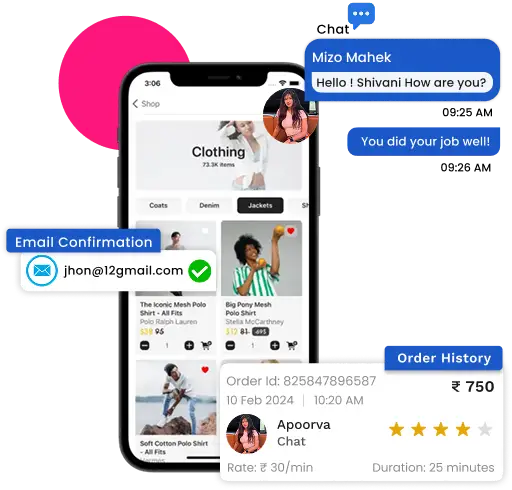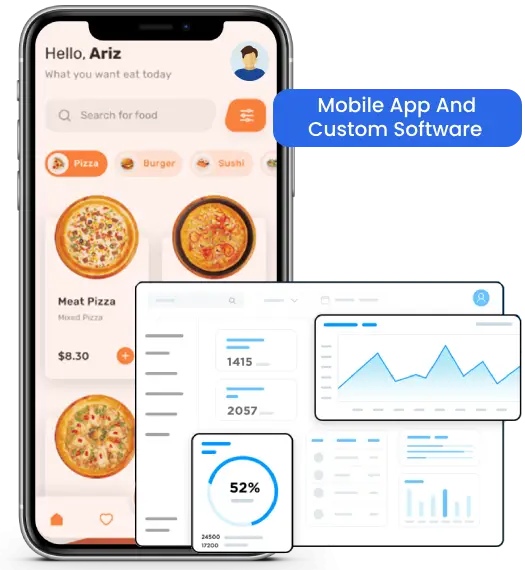Creating a product feels like embarking on an exciting journey where ideas, creativity, and hard work converge to deliver something valuable to the world. Every venture begins with a spark: a problem to solve, a need to fulfill, or simply a vision of something better. Budgets matter just as much as imagination, and the complexity of new product development cost estimation often keeps product teams and founders awake at night. Estimating development cost isn’t straightforward. Designers, engineers, testers, and project managers all play crucial roles. Every feature, integration, and quality checkpoint adds complexity and cost. Financial clarity builds confidence among stakeholders and ensures the roadmap stays realistic. Accurate estimates can help secure funding, manage expectations, and allow space for creativity without sacrificing feasibility. Bridging optimism and reality is where smart planning comes into play. Assigning cost breakdowns to each stage, understanding regional variations, and applying strategic cost-saving measures can transform guesswork into a solid plan. In this blog, we will uncover everything from understanding product development costs and the key factors that influence them to calculating new product development costs, breaking down expenses by development phase and region, and sharing smart ways to reduce overall spending.
Product Development Costs at a Glance
Product development costs include all expenses associated with taking an idea from concept to market ready. It covers research and validation, design (UI/UX), prototyping, front-end and back-end engineering, quality assurance, release and deployment, documentation, post-launch support, and maintenance. Every phase demands resources such as human time, tools, infrastructure, and overhead. Understanding each component helps manage overall expenditure and expectations throughout the journey.
What Factors Affect the Cost of Product Development?
Bringing a product idea to life involves many moving parts, and each decision can influence the overall budget. From technical considerations to design choices and team composition, several elements contribute to how much you’ll end up spending. Understanding these factors is essential for accurate planning and cost control throughout the development process.
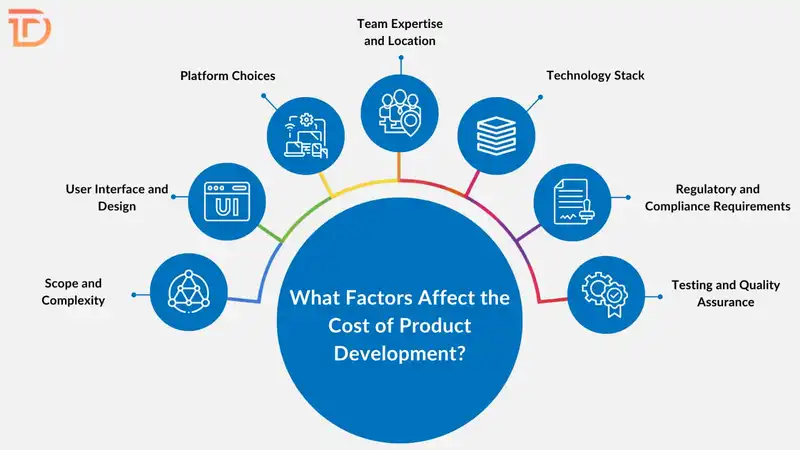
Scope and Complexity
The number of features, level of customization, integration with third-party services, and unique business logic all contribute to complexity. Larger or more innovative products require more planning, coding hours, and testing. Each added layer not only increases the time to build but also raises the final cost significantly.
User Interface and Design
A clean, intuitive, and attractive user interface takes more than basic design. Features like animations, transitions, accessibility, branding, and responsive behavior across devices all require additional design hours. Good design isn’t just aesthetic—it’s strategic, and higher-quality design investments usually lead to better user engagement and higher development costs.
Platform Choices
Building for a single platform such as Android, iOS, or web is typically more affordable than developing for multiple platforms at once. Using cross-platform technologies like Flutter or React Native can reduce duplication but may come with limitations or performance tradeoffs depending on the project’s complexity and technical requirements. Businesses seeking tailored custom mobile application development often need to weigh native performance against development efficiency when planning their budget.
Team Expertise and Location
The hourly rate of developers and designers varies greatly depending on experience and geographic location. Senior talent may charge more but often works faster and produces higher-quality results. Hiring a team from a cost-effective region can help reduce expenses, though it’s important to weigh communication and time zone challenges.
Technology Stack
Choosing modern tools and frameworks can boost scalability and performance but might demand higher upfront investment. Conversely, working with outdated or legacy systems often involves hidden challenges that require niche expertise. The more complex the tech stack, the more effort goes into setup, integration, testing, and long-term maintenance.
Regulatory and Compliance Requirements
Industries like finance, healthcare, and education must follow strict data protection and compliance standards. Building in features like end-to-end encryption, audit trails, and legal documentation workflows adds considerable development time. Ensuring the product meets legal and industry standards is critical but can significantly increase overall development costs.
Testing and Quality Assurance
Thorough QA involves more than just catching bugs. It includes manual and automated testing, usability testing, performance benchmarking, and compatibility checks across devices and browsers. Higher standards for quality assurance mean more time spent preparing test cases, running tests, and fixing issues, which all contribute to a higher total cost.
How Do You Calculate New Product Development Costs?
Calculating new product development costs requires a structured approach. A clear product development cost breakdown at each stage ensures transparency and helps avoid unexpected budget overruns. The following are essential steps for building accurate cost estimates:
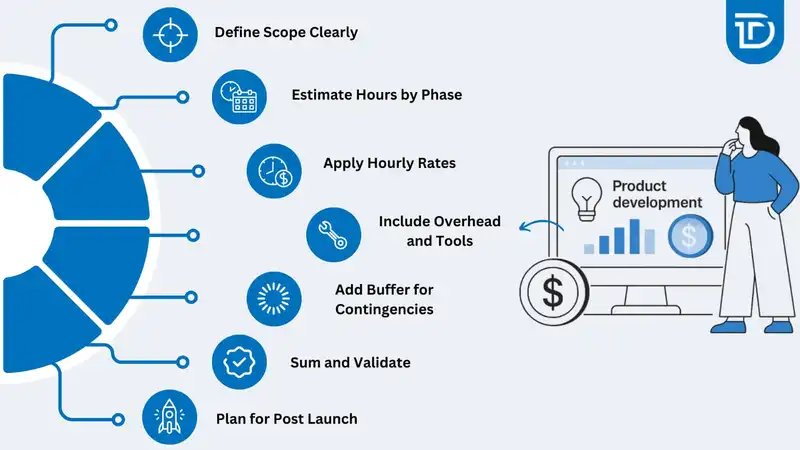
Define Scope Clearly
List all required features, technical specifications, user stories, and possible edge cases. A well-defined scope forms the foundation for precise cost projections and helps align expectations across product, design, and development teams from day one.
Estimate Hours by Phase
Break down the work into major phases such as UI/UX design, front-end development, back-end logic, QA testing, and deployment. Estimate the number of hours each phase will require based on team experience and the project’s overall complexity.
Apply Hourly Rates
Assign hourly rates to each role involved, such as designers, developers, QA testers, and project managers. Multiply those rates by the estimated hours to get a realistic view of the actual labor costs involved throughout the product development cycle.
Include Overhead and Tools
Factor in costs for third-party tools, paid libraries, cloud infrastructure, server hosting, API licenses, team communication software, and office utilities. These often-overlooked expenses are essential to the delivery and should be included in the total.
Add Buffer for Contingencies
Include a contingency buffer of around 10 to 20 percent of the estimated cost. This margin helps absorb unexpected scope changes, delays, or additional requirements that may emerge once development is in progress.
Sum and Validate
Once individual cost components are calculated, add them together to form a total estimate. Share the numbers with stakeholders for validation and refine them based on feedback, budget constraints, or shifting project priorities.
Plan for Post Launch
Budget for ongoing support and maintenance. Allocate around 15 to 20 percent of the initial development cost for updates, feature enhancements, bug fixes, and performance monitoring during the first year after launch.
Phase‑Wise Cost Estimation: Refined Breakdown
Understanding the breakdown of costs across development stages is essential for efficient planning and avoiding budget surprises. Below is a detailed look at each major phase involved in building a digital product, along with typical cost estimates.
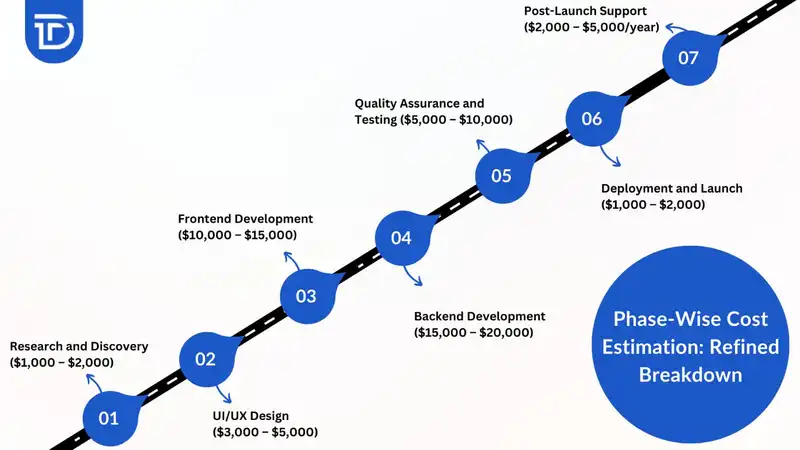
Research and Discovery
Research lays the groundwork for successful product development. Market analysis, user interviews, and competitive research help validate the concept before any design or code begins. Teams define the product’s core purpose, map out user needs, and clarify technical requirements. Solid discovery work prevents rework later, ensuring better ROI. Early clarity improves alignment across teams and helps avoid unnecessary delays or budget overruns.
Estimated Cost: $1,000 – $2,000
UI/UX Design
Design focuses on creating smooth, engaging user experiences that match business goals. The process involves wireframing, prototyping, and developing visual assets that guide users through the product naturally. High-quality design goes beyond looks—it supports usability, retention, and brand trust. Time spent here pays off through fewer user complaints and reduced customer support needs.
Estimated Cost: $3,000 – $5,000
Frontend Development
Frontend development builds everything users interact with directly. It includes implementing the UI using frameworks like React or Vue, ensuring responsiveness across devices, and optimizing for speed and accessibility. Visual consistency, interactive elements, and performance tuning all fall under this stage. A strong frontend contributes to a seamless user journey and boosts product credibility.
Estimated Cost: $10,000 – $15,000
Backend Development
Backend development handles everything users don’t see but rely on. This includes server architecture, data storage, API integration, and business logic. A solid backend ensures security, scalability, and reliability. Choosing the right architecture and framework can streamline future development. Well-written backend systems also make it easier to support new features and growth.
Estimated Cost: $15,000 – $20,000
Quality Assurance and Testing
Quality assurance ensures that the product works as expected under real-world conditions. Both manual and automated testing are used to catch bugs, ensure compatibility, and improve user experience. Testing includes device/browser checks, load testing, security validation, and usability feedback. A solid QA process reduces the risk of post-launch failures and improves customer satisfaction.
Estimated Cost: $5,000 – $10,000
Deployment and Launch
Deployment involves setting up servers, preparing apps for store submission, and ensuring everything runs smoothly before public access. Developers may configure CI/CD pipelines, cloud environments, and security certificates during this phase. A successful launch also involves monitoring, backup systems, and rollback plans in case of critical errors. Good deployment practices create a stable launch environment and faster user adoption.
Estimated Cost: $1,000 – $2,000
Post-Launch Support
Ongoing support keeps the product stable and responsive to user needs. Common tasks include fixing bugs, applying updates, monitoring system health, and gradually rolling out improvements. Regular maintenance ensures the product remains competitive, secure, and compatible with platform updates. A strong post-launch strategy also boosts user trust and extends product lifecycle.
Estimated Cost: $2,000 – $5,000/year
Carefully planning for each of these stages helps allocate resources where they matter most. Early phases may involve lower costs, but they shape the success of the entire product. Later phases typically require larger investments, especially as the project scales. Smart budgeting aligned with these milestones leads to better outcomes and fewer surprises.
Product Development Cost as Per Regions
Development costs vary significantly depending on where your team is located. Labor rates differ globally, and understanding regional differences helps businesses make informed decisions that balance quality, budget, and operational needs. Below is a breakdown of typical developer rates per hour across four major regions.
| Region | Developer Cost per Hour (USD) |
|---|---|
| USA | $120 – $200 |
| Europe | $80 – $150 |
| Russia | $40 – $70 |
| India | $25 – $50 |
Regional developer rates play a major role in shaping the total cost of product development. A project that might cost $100,000 when built with U.S.-based developers could potentially be completed for around $40,000 using talent from India. While factors like communication styles, time zone coordination, and cultural alignment should be considered, strategic teams focus on balancing budget with quality and collaboration efficiency.
India continues to grow as a top destination for outsourcing due to its vast talent pool, strong English proficiency, and proven experience with global clients. The country’s developer community is known for technical expertise, adaptability, and a deep understanding of international project demands. For businesses aiming to develop high-quality products while keeping costs manageable, India offers a compelling mix of affordability, capability, and reliable delivery.
Smart Ways to Reduce the Cost of Product Development
Product development doesn’t have to drain your entire budget. With the right planning, tools, and strategies, businesses can control expenses without compromising on performance or quality. Whether you’re a startup working with limited capital or an enterprise optimizing for efficiency, smart cost-saving techniques can make a big difference. The following are some of the most effective ways to reduce product development costs while still delivering exceptional results:
Prioritize Features (MVP)
Start with a Minimum Viable Product that focuses only on the most valuable features. Skip add-ons or advanced functionality until the product has been validated with real users. This helps you enter the market faster, collect feedback, and avoid unnecessary investment in features that may not deliver real user value.
Use Cross Platform Frameworks
Consider using frameworks like React Native or Flutter that allow you to build apps for multiple platforms using a single codebase. It significantly cuts down development time and cost while ensuring consistency across Android and iOS. Although performance might be slightly lower than native apps, the trade-off is often worthwhile for early-stage products.
Automate Testing
Automated testing tools can run thousands of test cases quickly and repeatedly without additional labor. Implementing automation early reduces the need for extensive manual QA, catches bugs before they escalate, and speeds up delivery. Long term, automation saves both time and cost while maintaining software stability with each new release.
Leverage Open-Source Tools
Take advantage of community-driven libraries, frameworks, and plugins to speed up development. Open-source tools are generally free and well-documented, which reduces custom coding time. Rather than building everything from scratch, selectively integrating trusted open-source components can help maintain quality while keeping the budget under control.
Adopt Agile Iterations
Break development into short, manageable sprints. Agile methodologies promote early feedback, continuous testing, and iterative improvements. Instead of committing to a large scope all at once, agile allows the team to pivot when needed and avoid spending time and money on features that may not align with evolving user needs.
Outsource Selectively
Consider outsourcing parts of the project—such as front-end development or testing—to reduce costs while maintaining in-house control over core areas. Outsourcing to reliable development partners in cost-effective regions allows you to scale quickly without overloading internal teams. This hybrid approach provides flexibility without compromising project ownership or quality.
Standardize Components
Develop a shared library of UI elements, microservices, and backend modules that can be reused across the application. Standardization reduces repetitive work, accelerates onboarding for new developers, and ensures consistent performance. Reusable components also simplify future updates and lower the cost of building new features or scaling the product.
Wrapping Up
Estimating product development costs requires careful breakdown at every stage, from research to post-launch support. Clear scope definition, realistic hourly rate assumptions, regional cost awareness, and smart cost-saving tactics offer financial clarity and strategic direction. Well-prepared budgets help maintain development momentum, stakeholder confidence, and alignment across teams.
At Dreamer Technoland, we offer end-to-end product development services, partnering with startups and enterprises to deliver efficient, high-quality solutions tailored to specific business goals. Our structured approach ensures complete transparency and helps avoid unexpected expenses. Whether you’re launching an MVP or scaling a full-featured app, our team provides clear cost planning, expert execution, and smart technology stacks. Reach out to explore how we can bring your vision to life without exceeding your budget.

